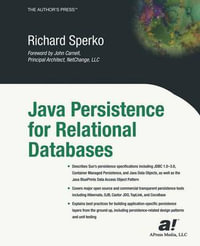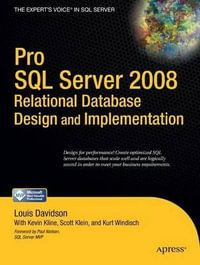
Inside Relational Databases with Examples in Access
By: Bill Marklyn, Mark Whitehorn
Paperback | 31 October 2006
At a Glance
388 Pages
New edition
23.2 x 17.6 x 2.6
Paperback
RRP $64.99
$57.50
12%OFF
or 4 interest-free payments of $14.38 with
orAims to ship in 7 to 10 business days
| Preface | p. xiii |
| Introduction | p. 1 |
| Who are we? | p. 1 |
| What is a database? | p. 2 |
| Databases vs. Database Management Systems | p. 3 |
| Relational Database Management Systems | p. 3 |
| Why this book? | p. 4 |
| Who should read this book? | p. 5 |
| Organization of the book | p. 6 |
| Some ground rules | p. 7 |
| Downloading files from the website | p. 8 |
| Acknowledgements | p. 8 |
| We don't have problems... | p. 9 |
| Outroduction | p. 9 |
| A simple, single-table database | p. 11 |
| Introduction to Part 1 | p. 13 |
| Tables | p. 13 |
| Queries/Views | p. 14 |
| Forms | p. 14 |
| Reports | p. 15 |
| Tables | p. 17 |
| Rows & columns - records & fields | p. 18 |
| Building a table | p. 22 |
| Types of data | p. 23 |
| Meaningful operations | p. 24 |
| Excluding certain errors | p. 26 |
| Making storage more efficient | p. 26 |
| Making data recall more rapid | p. 28 |
| Field size | p. 28 |
| General notes on table design | p. 29 |
| Queries/Views | p. 36 |
| Queries usually find subsets of the data | p. 36 |
| Queries, answer tables and base tables finally defined properly and closure mentioned briefly | p. 37 |
| Summarizing data | p. 42 |
| Other useful queries | p. 42 |
| Graphical querying tools | p. 43 |
| SQL and Views | p. 44 |
| Forms | p. 45 |
| Multiple forms per table | p. 48 |
| Text boxes can be made read only | p. 49 |
| Text boxes don't have to present data from just one field | p. 49 |
| It isn't necessary for each field in a table to appear on the form | p. 51 |
| Controlling data entry | p. 51 |
| Use of forms can be controlled | p. 51 |
| Forms can be web pages | p. 51 |
| Summary | p. 52 |
| Reports | p. 54 |
| Summary of Part 1 | p. 56 |
| A multi-table database | p. 59 |
| Introduction to Part 2 | p. 61 |
| Serious problems with single tables | p. 62 |
| Redundant data | p. 63 |
| Typographical errors | p. 63 |
| Modifying data | p. 64 |
| Summary | p. 65 |
| Multiple tables cure serious problems | p. 67 |
| Redundant data | p. 69 |
| Typographical errors | p. 72 |
| Modifying data | p. 72 |
| Making multiple tables work together | p. 73 |
| Databases are designed to model the real world | p. 74 |
| Getting the data into the correct tables | p. 75 |
| Not normalization (and not ER modeling either) | p. 77 |
| Object identification | p. 78 |
| Relationships in the real world | p. 81 |
| One-to-many | p. 81 |
| One-to-one | p. 82 |
| Many-to-many | p. 82 |
| None | p. 82 |
| Mapping real world relationships to tables | p. 83 |
| How are relationships modeled? | p. 84 |
| Primary keys | p. 86 |
| Foreign keys | p. 91 |
| Summary so far | p. 92 |
| Joins | p. 93 |
| General lessons about joins | p. 106 |
| Revisiting the big four - the synergy begins | p. 112 |
| Closure | p. 112 |
| Tables | p. 115 |
| Queries (and a bit on forms) | p. 116 |
| Forms | p. 123 |
| Reports | p. 124 |
| Integrity | p. 127 |
| Data integrity - is it worth the effort? | p. 127 |
| Types of data integrity error (and some cures) | p. 128 |
| Declarative and procedural referential integrity | p. 134 |
| Nulls in foreign keys | p. 139 |
| These options in context | p. 142 |
| Other integrity issues | p. 143 |
| Integrity - where should you set it? | p. 143 |
| Summary of Part 2 | p. 146 |
| Database Design & Architecture | p. 147 |
| Database design | p. 149 |
| Designing databases - user, logical and physical models | p. 149 |
| The Logical model - overview | p. 151 |
| More about the logical model | p. 152 |
| CASE tools | p. 154 |
| Summary so far | p. 158 |
| The final big advantage of CASE tools | p. 158 |
| More about the differences between the Logical and Physical models | p. 160 |
| Reality check | p. 162 |
| Normalization can help | p. 162 |
| Reverse engineering | p. 163 |
| Methodologies | p. 164 |
| Summary of design models | p. 164 |
| The seven layers of wisdom | p. 165 |
| The seven layers of wisdom | p. 165 |
| Database architecture | p. 168 |
| Default Architecture in Access | p. 168 |
| Access - PC front end - data on file server | p. 168 |
| Client-server (or two-tier) architecture | p. 171 |
| Three-tier architecture (also known as multi-tier) | p. 173 |
| Web-based applications | p. 174 |
| Choosing a database architecture | p. 176 |
| What comes next | p. 177 |
| Related database topics | p. 179 |
| What exactly is a relational database? | p. 181 |
| Do multiple tables a relational database make? | p. 181 |
| Triggers and stored procedures | p. 183 |
| Triggers | p. 183 |
| Stored procedures | p. 187 |
| Summary - triggers and stored procedures | p. 189 |
| Transactions, logs, backup, locking and concurrency | p. 190 |
| Transactions | p. 190 |
| Logs | p. 191 |
| Locking | p. 197 |
| Concurrency | p. 199 |
| Row locking and page locking | p. 199 |
| Access and the features described in this chapter | p. 200 |
| Answers from earlier | p. 200 |
| Codd's rules | p. 201 |
| Codd's rules | p. 201 |
| Economy vs. readability | p. 201 |
| A little background | p. 202 |
| The rules themselves | p. 202 |
| Summary | p. 213 |
| Normalization | p. 215 |
| A first look at normalization | p. 215 |
| First normal form (first level of normalization): 1NF | p. 216 |
| Second normal form (second level of normalization): 2NF | p. 218 |
| Third normal form (third level of normalization): 3NF | p. 220 |
| Summary so far | p. 221 |
| Adding some definitions | p. 222 |
| Summary (again) | p. 231 |
| More about normalization | p. 233 |
| Higher normal forms | p. 233 |
| Normalization doesn't automatically remove all redundancy | p. 237 |
| Summary | p. 242 |
| The system tables | p. 244 |
| More on queries: data manipulation | p. 246 |
| Relational operators | p. 246 |
| Summary | p. 256 |
| SQL | p. 258 |
| SELECT and FROM | p. 261 |
| DISTINCT | p. 262 |
| WHERE | p. 262 |
| Conditions | p. 263 |
| ORDER BY | p. 267 |
| Wildcards | p. 270 |
| Sub-queries | p. 271 |
| Built-in functions | p. 272 |
| GROUP BY - collecting information | p. 276 |
| GROUP BY...HAVING - collecting specific information | p. 282 |
| Working with multiple tables | p. 285 |
| Inner (Natural) joins | p. 290 |
| Outer joins | p. 291 |
| UNION | p. 293 |
| SELECT summary | p. 296 |
| INSERT | p. 297 |
| UPDATE | p. 300 |
| DELETE | p. 302 |
| A question (and a free SQL diagnostic tool) | p. 303 |
| Summary | p. 306 |
| Domains | p. 307 |
| What does null mean? | p. 309 |
| Primary keys | p. 313 |
| Candidate keys | p. 315 |
| Speeding up your database | p. 317 |
| Hardware considerations | p. 319 |
| CPUs | p. 320 |
| Memory | p. 320 |
| Disks | p. 322 |
| Data volume vs. disk capacity | p. 322 |
| Don't put all your eggs in one basket | p. 323 |
| Indexing | p. 324 |
| Indexing techniques | p. 324 |
| Applying indexes - which fields/columns should be indexed? | p. 333 |
| Intelligent use of indexes | p. 337 |
| More on optimization | p. 338 |
| Query optimization | p. 338 |
| Update statistics | p. 339 |
| Query analysis | p. 340 |
| Writing good SQL code | p. 342 |
| Denormalization | p. 344 |
| Mirroring tables | p. 345 |
| Splitting tables | p. 346 |
| Redundant data | p. 348 |
| Repeating groups (breaking 1NF) | p. 349 |
| Derived columns | p. 351 |
| Summary | p. 352 |
| GUIs, macros and control languages | p. 353 |
| Creating a very simple user interface | p. 353 |
| Other languages - SQL | p. 362 |
| Index | p. 365 |
| Table of Contents provided by Ingram. All Rights Reserved. |
ISBN: 9781846283949
ISBN-10: 1846283949
Published: 31st October 2006
Format: Paperback
Language: English
Number of Pages: 388
Audience: Professional and Scholarly
Publisher: Springer Nature B.V.
Country of Publication: GB
Edition Type: New edition
Dimensions (cm): 23.2 x 17.6 x 2.6
Weight (kg): 0.75
Shipping
| Standard Shipping | Express Shipping | |
|---|---|---|
| Metro postcodes: | $9.99 | $14.95 |
| Regional postcodes: | $9.99 | $14.95 |
| Rural postcodes: | $9.99 | $14.95 |
How to return your order
At Booktopia, we offer hassle-free returns in accordance with our returns policy. If you wish to return an item, please get in touch with Booktopia Customer Care.
Additional postage charges may be applicable.
Defective items
If there is a problem with any of the items received for your order then the Booktopia Customer Care team is ready to assist you.
For more info please visit our Help Centre.
You Can Find This Book In

Artificial Intelligence and Actuarial Science
Applications and Case Studies from Finance and Insurance
Hardcover
RRP $305.00
$215.80
OFF






















